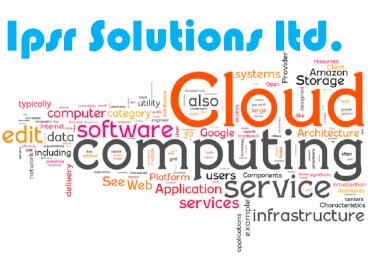Cloud Computing - PowerPoint PPT Presentation
Title:
Cloud Computing
Description:
Cloud Computing is a term used to refer to a model of network computing where a program or application runs on a connected server or servers rather than a local computing device such as a PC, tablet or Smartphone. www.ipsrglobal.com – PowerPoint PPT presentation
Number of Views:2465
Title: Cloud Computing
1
Ipsr Solutions ltd.
2
(No Transcript)
3
What is Cloud Computing?
- Cloud Computing is a term used to refer to a
model of network computing where a program or
application runs on a connected server or servers
rather than on a local computing device such as a
PC, tablet or Smartphone. - A Cloud is a computer network to Store, Access
and Share Data from Internet Connected Devices.
4
Why Cloud Computing?
5
What is the need for Cloud Computing?
Why Cloud Services?
6
- The need for Cloud Services arose from Increased
Importance being given to IT Services in a
Business Organization.
Which is a result of changes in Business Strategy
Goals of the Organization due to stiff
competition and their need to survive grow.
7
Business Goals V/s IT Spend
- Businesses have big ideas !
- Drive Sales
- Increase Revenues
- Cut Costs
- But IT Infra (expansion) Business Apps are
expensive leading to heavy CAPEX on IT - This is a major problem for the CIOs
8
Issues in IT Infra expansion
- Space Issue
- Infra Issue
- Management Approval
- Finance Approval
- Vendor Identification Rating
- Elaborate Procurement Process
- Delivery Time Delay
- IT Human Resources
- Installation Integration
- Networking Telecom
- Testing Training
9
Facts for Cloud Growth
- 1. Cut Costs on one side
- 2. Heavy CAPEX on IT on the other side
- 3. Improved Telecom Connectivity
- 4. Business Process Outsourcing
10
Cloud Model
11
The Optimal Solution
Migrate to Cloud Computing Business Organization
Outsource computing services to a CSP Convert
Capital expenditures to operating expenditure in
IT Services Cloud Service Business Model
Provide Computing Resources to various
customers on Sharing basis
12
Cloud Advantages
13
Deployment Models
14
(No Transcript)
15
Types of Cloud Services
16
Service Model Types
17
Red Hat Open Technology made for the Cloud
18
Benefits of Going to the Cloud
- Cos can save a lot of money
- Convert Capital Capital Expenditures to Operating
Expenditure - Pay-per-use
- Robust Scalability
- Reduce IT manpower
- Cos can save lot of valuable time
- Instant availability
- Cos can avoid mishaps
- Cos on concentrate of Growth/Profits
19
Pay Per Use Resources
- Per vCPU/Hour
- Per GB RAM/Hour
- Per 50 GB Storage/Hour
- Shared Network Segment/Hour
- Data Transfer/GB/Hour
- Includes VLAN, Load Balancing, Switching,
- Routing Managed Firewall
20
Do You Use Cloud?
21
Learn Cloud?
22
What is Open Stack?
- Open Stack is a global collaboration of
developers and cloud computing technologists
producing the ubiquitous open source cloud
computing platform for public and private clouds.
The project aims to deliver solutions for all
types of clouds by being simple to implement,
massively scalable, and feature rich.
23
Who uses Open Stack?
- Corporations, service providers, VARS, SMBs,
researchers, and global data centers looking to
deploy large-scale cloud deployments for private
or public clouds leveraging the support and
resulting technology of a global open source
community.
24
Virtualization
- Virtualization is the creation of a virtual
(rather than actual) version of something, such
as an operating system, a server, a storage
device or network resources.
25
(No Transcript)
26
Benefits of Virtualization
- Hardware Abstraction
- Ease of Migration
- Encapsulation of Storage
- Ease of Growth
- Workload Consolidation
- Improved Remote Management
- Improved Monitoring and Troubleshooting
27
Red Hat Storage
- Red Hat Storage is a new distributed file system
(DFS) based on the Gluster file system. - A distributed file system is a client/server-based
application that allows clients to access and
process data stored on the server as if it were
on their own computer. Red Hat Storage acts as a
scale-out network-attached storage (NAS)
and object storage software solution.
28
Benefits of Red Hat Storage
- Eliminates the need for proprietary storage
systems - Storage can be configured in a variety of ways
- Redundancy is built-in
- Files are presented as one file system structure
independent of the underlying physical storage
location - Offers scalable storage in the data center or
on-premise private cloud
29
(No Transcript)
30
Red Hat Certifications in Cloud Computing
- Red Hat Certified Virtualization
Administration(RH318) - Red Hat OpenStack Administration (CL210)
- Red Hat Storage Server Administration (RH236)
- Red Hat Enterprise Clustering and Storage
Management (RH436) - High Availability with Red Hat Enterprise Linux
OpenStack Platform (CL332) - Red Hat CloudForms Hybrid Cloud Management (CL220)
31
A practical list of steps to take to jump-start
your cloud project.
- Educate the IT team.
- Adopt a Cloud First policy for any new
projects. - Move test and development to the public cloud.
- Review your IT maintenance schedule.
- Convene a cross-functional project planning team
to identify workloads to migrate. - Hire an expert to spearhead the project.
- Consider ongoing cloud support needs.
- Build the migration and integration project plan.
32
The CIO Before and After Cloud
33
Better Utilization of IT Manpower
34
Which one would you prefer ?
35
(No Transcript)































